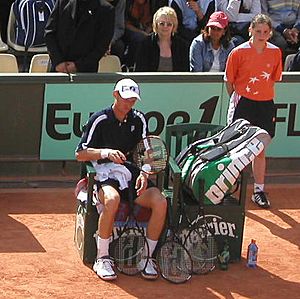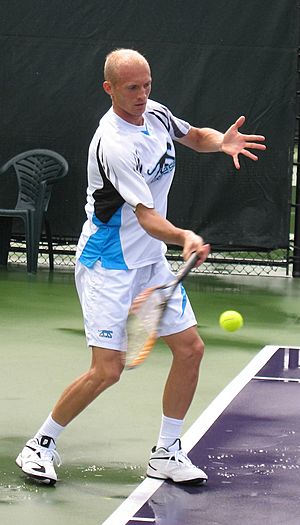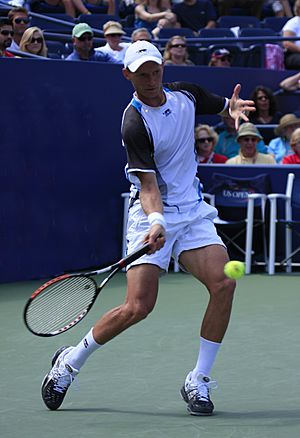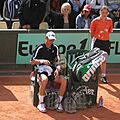Nikolay Davydenko facts for kids
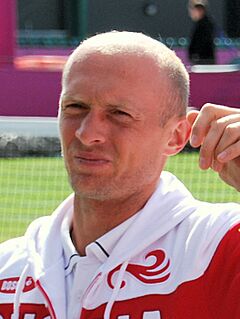
Davydenkjo at the 2012 Olympics
|
|
| Native name | Николай Давыденко |
|---|---|
| Country (sports) | |
| Residence | Volgograd, Russia |
| Born | June 2, 1981 Sievierodonetsk, Ukrainian SSR, Soviet Union |
| Height | 1.78 m (5 ft 10 in) |
| Turned pro | 1999 |
| Retired | 2014 |
| Plays | Right-handed (two-handed backhand) |
| Coach | Eduard Davydenko |
| Prize money | US$16,186,480
|
| Singles | |
| Career record | 482–329 (59.3%) |
| Career titles | 21 |
| Highest ranking | No. 3 (6 November 2006) |
| Grand Slam singles results | |
| Australian Open | QF (2005, 2006, 2007, 2010) |
| French Open | SF (2005, 2007) |
| Wimbledon | 4R (2007) |
| US Open | SF (2006, 2007) |
| Other tournaments | |
| Tour Finals | W (2009) |
| Olympic Games | 2R (2008, 2012) |
| Doubles | |
| Career record | 61–67 (47.7%) |
| Career titles | 2 |
| Highest ranking | No. 31 (13 June 2005) |
| Grand Slam doubles results | |
| Australian Open | 2R (2005) |
| French Open | 3R (2005) |
| Wimbledon | QF (2004) |
| US Open | 2R (2004, 2005) |
| Team competitions | |
| Davis Cup | W (2006) |
Nikolay Davydenko is a former professional tennis player from Russia. He was born on June 2, 1981. He reached his highest singles ranking of World No. 3 in November 2006.
Davydenko was very successful in his career. He reached the semi-finals of Grand Slam tournaments four times. These included two times at the French Open and two times at the U.S. Open. His biggest win was the 2009 ATP World Tour Finals. He also won three ATP Masters Series titles. Nikolay Davydenko stopped playing professionally in October 2014.
Contents
About Nikolay Davydenko
Nikolay Davydenko was born in Sievierodonetsk, which was then part of the Soviet Union. He started playing tennis at age 7 with his older brother, Eduard. Eduard was a tennis coach for children.
Moving for Tennis Training
When Nikolay was 11, he moved to Volgograd, Russia. His brother Eduard helped him move there. Eduard believed Nikolay needed to leave his hometown to become a better tennis player.
Four years later, in 1996, the brothers moved again. They went to Salmtal, Germany, for the same reason. Nikolay said that in Europe, he could play more tournaments. He could also earn more money than in Russia.
The brothers lived in Germany for three years. They tried to become German citizens. However, the German Tennis Federation did not agree. So, they returned to Russia.
Citizenship and Family Life
In 1999, when he was 18, Nikolay became a Russian citizen. He had been a Ukrainian citizen before that. In 2007, he tried to get Austrian citizenship. He wanted it because it was hard to get travel visas with a Russian passport. But he was not able to get it.
Nikolay is married to Irina, who used to be a model. They got married in 2006. They have three children: a daughter named Ekaterina (born 2012) and two sons, Konstantin (born 2015) and Dmitry (born 2017). His nephew, Philipp Davydenko, also played professional tennis. Nikolay speaks Russian, German, and English.
Nikolay's Tennis Journey
Nikolay Davydenko started playing tennis at age seven. His brother Eduard was his first coach. They moved to Germany to help Nikolay improve his game. This move also allowed him to play in more tournaments.
Becoming a Professional Player
Davydenko became a professional tennis player in 1999. In 2000, he played mostly on the Futures Tour. He won one title and reached three finals. He played his first ATP tournament in Amsterdam. He reached the semi-finals there. Later that year, he won his first Challenger title.
Early Career Highlights (2001–2003)
In 2001, Davydenko played in his first Grand Slam at the Australian Open. He reached the second round. This showed people his talent. He later won two more Challenger titles.
In 2002, he continued to play in ATP and Challenger events. He reached the quarter-finals in a few tournaments. He also won his fourth Challenger title.
Davydenko made big progress in 2003. He won his first ATP title in Adelaide. A few months later, he won his second title in Estoril. He also played well on clay courts. By the end of 2003, he was in the top 50 players in the world.
Breaking Through (2004)
Davydenko continued to improve in 2004. He won two more titles that year. He won his third title in Munich. In October, he won his first tournament in his home country, Russia. This was in Moscow, where he won both singles and doubles. He finished 2004 in the top 30.
Peak Years (2005–2009)
Rising to the Top 10 (2005)
In 2005, Davydenko reached the quarter-finals of a Grand Slam for the first time. This was at the Australian Open. He won his fifth career title in St. Pölten. He then reached his first Grand Slam semi-final at the French Open. He beat Guillermo Coria, a strong player, in the fourth round. This showed how much he had improved.
Davydenko lost in the French Open semi-finals. After this, he entered the top 10 players in the world. He finished 2005 as the No. 1 Russian player and world No. 5.
Staying in the Top 5 (2006)
Davydenko stayed in the top 5 throughout 2006. He reached the Australian Open quarter-finals again. He defended his title in Pöertschach. He also reached the French Open quarter-finals for the second year. He won titles in Sopot and New Haven. He reached his second Grand Slam semi-final at the U.S. Open.
He finished the season with a win in Moscow. He also won his first TMS title in Paris. After getting married, Davydenko helped Russia win the Davis Cup against Argentina. He reached his career-high ranking of No. 3.
Another Strong Year (2007)
In 2007, Davydenko reached the Australian Open quarter-finals for the third year in a row. He found his form during the clay court season. He reached the semi-finals at the Rome Masters and the French Open. He surprised many by reaching the fourth round at Wimbledon. This was his least favorite surface.
He had strong performances in the US hard-court season. He reached the semi-finals of the U.S. Open for the second year. He won his eleventh career title in Moscow. He also played in the Masters Cup in Shanghai. Davydenko ended 2007 ranked No. 4.
Winning a Big Title (2008)
Davydenko started 2008 well. He won his biggest title yet at the Miami Masters. On his way to winning, he beat Andy Roddick and Rafael Nadal. This was his second ATP Masters Series title.
He reached the final of the Estoril Open. He won his thirteenth career title in Pöertschach. He also won a title in Warsaw. Davydenko played at the 2008 Summer Olympics in Beijing. He reached the semi-finals at the Paris Masters. He qualified for the Tennis Masters Cup for the fourth year. He reached the final but lost to Novak Djokovic. Davydenko finished 2008 ranked No. 5.
Winning the ATP Finals (2009)
Davydenko started 2009 with an injury. This forced him to miss the Australian Open. He returned to play in April. He reached the quarter-finals in Monte Carlo. He also reached the semi-finals in Barcelona. His ranking dropped out of the top 10 for a short time.
He reached the quarter-finals at the French Open. He then won two titles in a row: the 2009 International German Open and the 2009 ATP Studena Croatia Open Umag. He won his third title of the year at the 2009 Proton Malaysian Open. He also won the 2009 Shanghai Rolex Masters by beating Rafael Nadal in the final.
At the 2009 ATP World Tour Finals in London, Davydenko played very well. He beat Roger Federer for the first time in the semi-finals. He then won the final against Juan Martín del Potro. This made him the first Russian player to win this important event. Davydenko finished 2009 ranked No. 6.
Later Career (2010–2014)
Wrist Injury (2010)
Davydenko started 2010 by winning the 2010 Qatar ExxonMobil Open. He beat both Roger Federer and Rafael Nadal in the same tournament. This was a rare achievement. At the Australian Open, he reached the quarter-finals.
However, he injured his wrist in February. This injury caused him to miss several tournaments. He returned to play on grass courts. He struggled to win matches consistently after his injury. He did not qualify for the Barclays ATP World Tour Finals that year. His ranking dropped out of the top 20.
Decline and Retirement (2011–2014)
In 2011, Davydenko's form continued to decline. He reached the final of the Qatar Open, but lost to Roger Federer. He won his 21st ATP title at the 2011 BMW Open. This meant he had won at least one ATP title for nine years in a row.
2012 was a tough year for Davydenko. He lost in the first round of all four Grand Slam tournaments. He played for Russia at the 2012 London Olympic Games. He won his first-round match in singles but lost in the second. He also played doubles.
In 2013, he reached the finals of the Qatar ExxonMobil Open again. He beat David Ferrer, who was ranked No. 5. He finished 2013 ranked No. 53.
In 2014, Davydenko struggled to win matches. He lost in the first or second round of most tournaments. He decided to skip the grass court season. On October 16, 2014, Nikolay Davydenko announced his retirement from professional tennis.
How Nikolay Played
Davydenko had an aggressive playing style. He hit powerful shots from the back of the court. His shots were very accurate. He was very fast on the court. This allowed him to hit the ball early. He often caught his opponents off guard.
His best shot was his backhand. He could hit it in many different ways. He was known for hitting winning shots while running. His serve was consistent, but not super powerful. He played well on all surfaces, especially hard and clay courts.
Areas for Improvement
Davydenko's volleys were not as strong as his groundstrokes. Sometimes, he found it hard to finish matches. He lost some important matches even when he was ahead. For example, he lost leads against Roger Federer in Grand Slam matches. Later in his career, he tried to add more variety to his game. He started using slice shots and coming to the net more often.
Equipment Used
In the middle of 2010, Nikolay Davydenko started using Dunlop Sport racquets. He used the Dunlop Biomimetic 200 Plus. In 2012, he switched to the Prince Ozone Pro Tour racquet. By 2014, he was playing with a Babolat AeroPro Drive GT racquet.
Towards the end of his career, Davydenko wore Asics shoes and clothing. Before that, he used the brand Airness.
Images for kids
See also
 In Spanish: Nikolái Davydenko para niños
In Spanish: Nikolái Davydenko para niños


